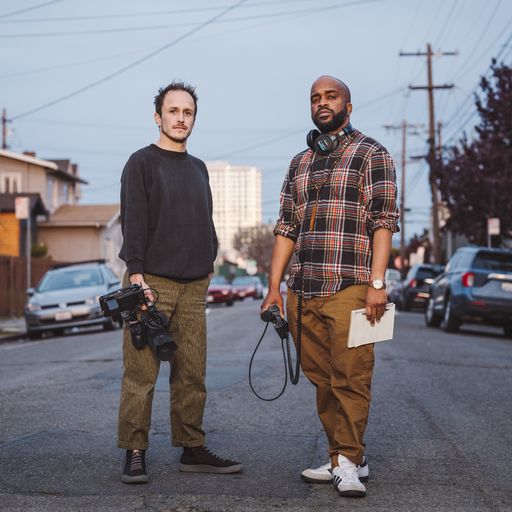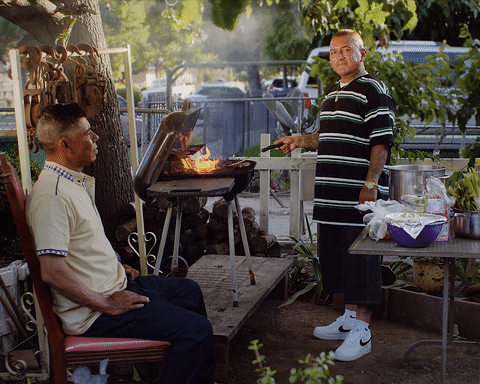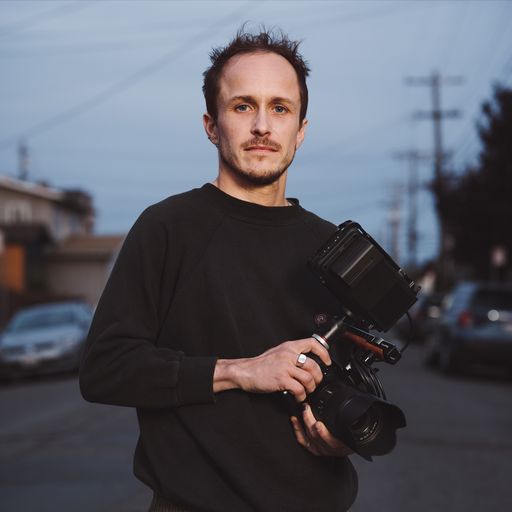A stunning multimedia lens on mass incarceration and its aftermath: The story behind “Facing Life”
After a decade of state prison reform, California has approved record levels of early releases in an attempt to reverse the tide of mass incarceration that saw deadly overcrowding and unlivable conditions become the state prison system’s norm.
But what do you do when granted another chance at life? After decades inside, where do you go, how do you get there, who is helping you, how are you doing? These are some of the questions California-based photographer and filmmaker Brandon Tauszik and writer Pendarvis Harshaw sought to answer about their home state’s recently paroled former “lifers” — people previously sentenced to life in prison.
The result is Facing Life, a 3-year, 8-part documentary multi-media project of profiles about the formerly life-sentenced incarcerated of California. Beginning in 2018, the duo used filmed interviews, immersive 360-degree VR video, cinemagraphs — still photos with minor and repeated movements — and the written word, to document the lives of Traveille, Lynn, Gary, Fahim, Myra, Jose, Robin, and Melvin as they navigate life outside. The story has since been published in the Los Angeles Times.
Storybench spoke with Tauszik and Harshaw over email to find out how Facing Life came together. (All images come courtesy of Facing Life and its creators.)

How did the idea for Facing Life come about?
B: Pendarvis and I had already known of each other’s work and had mutual friends in Oakland’s creative scene. Mass incarceration is arguably one of the largest social issues plaguing the United States, but I felt unequipped to make a project alone about such a complex issue. Pendarvis had just finished up at Berkeley’s Graduate School of Journalism and was teaching English in a prison. It’s difficult to get media access in prisons without a large publication backing you, so we decided to profile former lifers reentering society after decades behind bars. We applied for a grant from The Pulitzer Center and hit the ground running.
P: Yes, adding to what Brandon said, because of my experience teaching in prisons (as well as working with the San Quentin News – a newspaper made by people who are currently incarcerated), I knew about the overcrowding in California’s prisons. I also knew the state was in the midst of trying to do something about it; they were legally required to do so.
Brandon and I put our heads together and decided to investigate the question of what services and support systems are there when a person gets out of prison, specifically someone who had served the better portion of a life sentence. The tales of these folks, people who were once sentenced to life but had been granted another chance due to changed laws, inspired the title of this project: facing life.
What was the actual execution of Facing Life like end-to-end?
B: We began with information gathering; meeting with social justice and reentry organizations, a federal judge, the former Secretary of CDCR, as well as other formerly incarcerated people. We had a lot to learn regarding the labyrinth of policy and laws surrounding the issue. Then finding our eight participants took a long time, as we were looking for geographic, racial, and gender diversity. We ended up with three people in Northern California, three in Central and two in Southern.
After that, we checked in with them periodically over the course of two to three years, sometimes phone calls, sometimes shoots, sometimes just meals to catch up. Covid delayed the project’s release, so we began building the website and editing the content while continuing to check in with everyone’s stories as they evolved. Then we spent a few months setting up media placements and released it with a premiere in the print & digital LA Times.
P: And since the piece has been published, we’ve been spreading the word, both online and in real life. We’ve had a number of publications feature the work, we’ve had events where the people interviewed in the piece have spoken to audiences, and we’ve traveled to colleges and universities to speak to students and faculty about our work. It’s been a long road, but we’re excited to share it and keep the conversations on this topic going.

Tell me about your choice to incorporate so many forms of media, and why you choose the media you did.
B: The format of Facing Life is a more developed version of my previous projects Tapered Throne and Syria Street. In creating a project that will primarily live online, that opens you up to so many options in terms of media. I wanted the cinemagraphs to be the primary visual, backed up with concise first person interview videos. The 360 VR clips allow the viewer some autonomy to jump into everyday moments with the participants. Pendarvis’ text, which does the bulk of the actual storytelling, also focuses on the first person point of view. Creating an immersive experience was paramount, and we worked with the digital agency Fifty & Fifty to build out the project’s website.
P: Brandon’s cinemagraphs are, in a way, the purpose of the project. Yes, video is important. And of course the written portion is necessary. But one of the major goals of this piece was to get the general population to slow down and see people who’ve been incarcerated as people. See them as workers and churchgoers. Someone at the gym or someone changing their oil. Just another person at a BBQ, you know? This project isn’t just about the justice system, prisons and laws. It’s about society as a whole and how we look at people. So the cinemagraphs really serve that purpose.

What were some difficulties you faced when creating Facing Life and presenting it visually?
B: It was definitely difficult to compress so many stories down to something that’s digestible and scrollable, but substantial, too. Pendarvis worked his magic in condensing hours and hours of interviews into around 1,000 words per person. We wanted something you could deep dive on or skim, depending on who you are and how much time you have. Some viewers will mostly read and others will just click play on videos. Ideally, you can still take away something insightful from the project no matter how you interact with it.
P: Fitting someone’s life story into a few paragraphs is never simple. Interviewing someone who has been incarcerated for decades, allowing them space to open up and share their whole story — and then cutting down their quotes to make it fit your word count — that doesn’t make it easy to sleep at night. Speaking of losing sleep, this piece mentions some pretty heavy events. Lives were lost. People and communities were impacted. And from a bird’s eye view, you see the larger issues in society: broken homes, lack of resources, miseducation, immigration policy issues, racism, sexism and misogyny. It’s all there. It’s a lot to take in.
What was most impactful or shocking about the subjects’ stories?
B: I think one insight that struck me was that only one of our eight participants finished high school. All were raised in low-income zip codes. That alone says so much about the reality of the “school to prison pipeline.” Another insight would be that all three of the women we profiled had very negative experiences with men during the lead-up to their crimes.
P: What was shocking was what shocked the people we interviewed, especially in regard to technology. After serving three decades in prison, getting out and using an automatically flushing urinal is a different experience. The first encounter with Bluetooth, a Pumpkin Spice Latte or the price of chips and soda at 7-11. Things that we accept as the norm, but if you think about it, it’s all a bit odd.
And I’d add that I took their stories home with me. Now when I hear about people who’ve been incarcerated that are being deported upon release from prison, I think about Gary’s story. Or when I hear a rap artist shout out Watts or Nickerson Garden Projects, I think about Melvin. Or when I spend time with my daughter, I think about Jose’s relationship with his daughter or Myra’s relationship with her grandfather. These stories have definitely impacted me beyond journalism.

How were you able to separate yourselves from your subjects after filming them so closely about such sensitive subject matter?
B: We definitely got close to everyone during the process, and we’re still on a friendly text message basis. But we set boundaries up front with the type of content we would be publishing, and everyone that committed to the project was fine with that. We didn’t give any sort of editorial control before publishing.
P: Yes, as Brandon said, we were clear that we’re here to tell their story for a larger purpose. We are journalists, documentarians. And establishing that from the onset was key to having healthy boundaries.
What’s the response to Facing Life been so far?
B: The response has been really positive overall. We’ve had writeups in the British Journal of Photography, Huck Magazine, Buzzfeed News, as well as an op-ed in The Guardian, and more. It’s become a trans-media project in some ways; we brought Travielle with us on the radio; it’s had a separate life on TikTok; the San Quentin News will publish it in their newspaper next year. And we will (hopefully) do a touring physical exhibition. We want the project to be useful within the reentry space and ideally help shift policy in some way.
P: It’s been well-received across the board: teachers, artists, students, and all. It’s been great to see other people who were incarcerated react to it and share their stories. I’m excited to have more events and speaking engagements in-person. The real gold is in the conversations on the topic– conversations that we hope will lead to change.

What do you see as being the next steps in visual journalism?
B: I don’t consider myself a journalist, but I’m adjacent to the field in some ways. I think there will be some interesting solutions to image authentication problems, more VR would be nice as the tech improves, and I foresee AI being used to mine and present data or rapidly edit video.
P: I’m doing what I can to step away from screens as much as possible. I think there’s going to be a push back toward print, eventually. Kind of like how records have made a (read: minor) comeback. I think there will be more boutique or artisanal periodicals in the future… One can dream.
About the creators

Brandon Tauszik is a photographer and filmmaker living between Los Angeles and Oakland, California. He works on a combination of long-term projects, editorial stories and brand work.

Pendarvis Harshaw is a writer from Oakland. He currently works for one of National Public Radio’s San Francisco-based affiliates, KQED, where he writes columns about arts and culture in Northern California and hosts a podcast/ radio show called Rightnowish.





